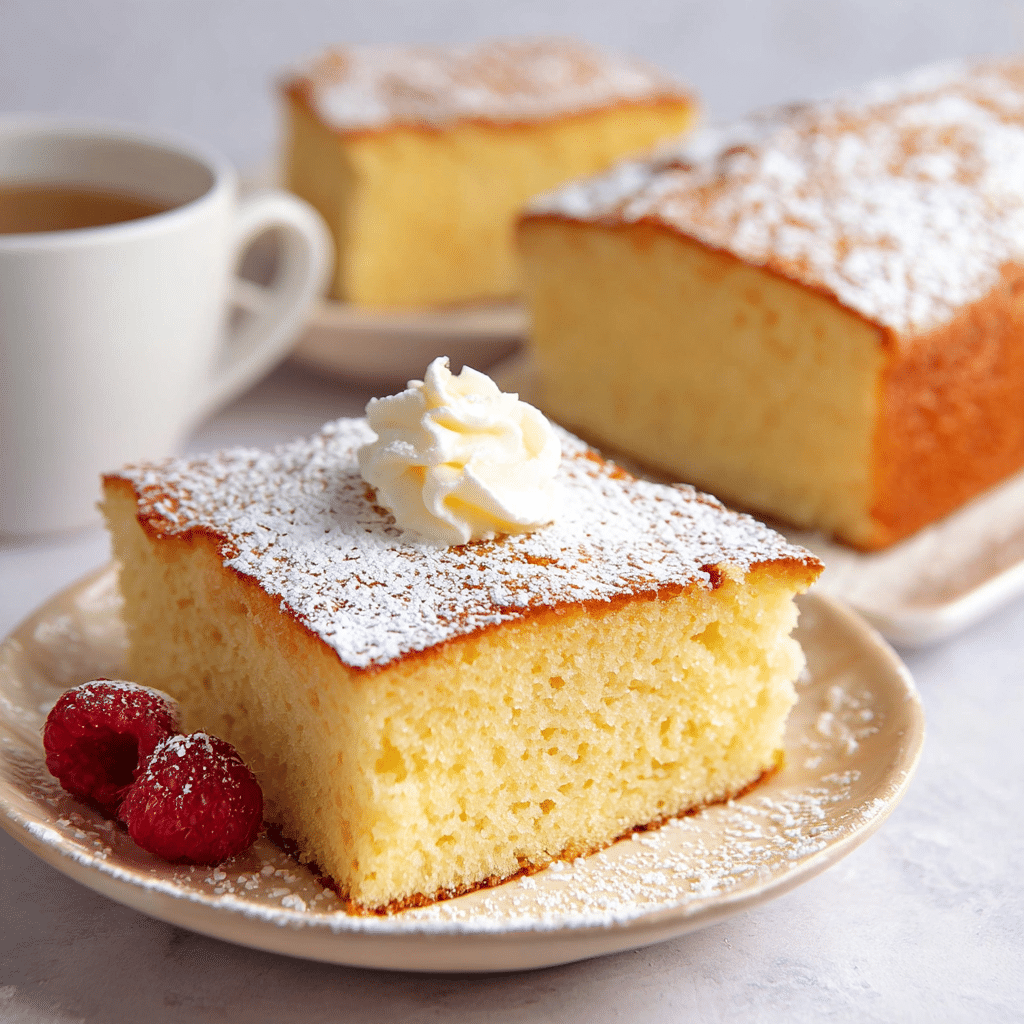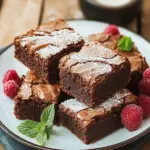This timeless hot milk cake is as comforting as it is simple. The airy, delicate crumb comes from beating the eggs and sugar until light and fluffy, while the addition of hot milk and butter creates a silky richness that melts in your mouth.
Whether enjoyed plain, dusted with powdered sugar, or dressed up with whipped cream or glaze, this cake brings cozy, homemade warmth to every slice. It’s perfect for afternoon tea, family gatherings, or just a sweet moment to yourself.
Full Recipe
Ingredients:
-
2 cups (250 g) all-purpose flour
-
2 cups (400 g) granulated sugar
-
2 tsp baking powder
-
½ tsp salt
-
4 large eggs, room temperature
-
1 cup (240 ml) whole milk
-
½ cup (113 g) unsalted butter, cubed
-
2 tsp vanilla extract
Directions:
-
Preheat oven to 350 °F (175 °C). Grease and flour a 13×9″ baking pan.
-
In a bowl, whisk together flour, baking powder, and salt; set aside.
-
In a stand mixer, beat eggs and sugar on medium-high speed until pale, thick, and doubled in volume, about 4–5 minutes.
-
In a small saucepan over low heat, combine milk and butter. Heat until the butter melts and bubbles form around the edges. Do not boil.
-
With the mixer on low, slowly pour in the hot milk and butter mixture.
-
Add the dry ingredients in two batches, mixing just until incorporated.
-
Pour the batter into the prepared pan and bake for 35–40 minutes, or until a toothpick inserted into the center comes out clean.
-
Cool in the pan for 10 minutes, then remove to a wire rack to cool completely. Dust with powdered sugar or frost as desired.
Prep Time: 15 minutes | Cooking Time: 40 minutes | Total Time: 55 minutes
Kcal: ~300 kcal | Servings: 12
The History and Origins of Hot Milk Cake
Hot Milk Cake is a classic American dessert with roots that trace back to early 20th-century baking traditions. It gained popularity in a time when home baking was central to family life and cookbooks began spreading widely throughout the United States. Unlike traditional sponge cakes that rely heavily on whipped egg whites for their light texture, hot milk cake uses a unique technique involving hot milk and melted butter added directly to the batter. This method creates a moist, tender crumb without the need for complex steps or additional ingredients like sour cream or buttermilk.
This cake quickly became a household favorite because of its simplicity and versatility. It was often considered a “bridge” cake — richer and softer than basic pound cakes but easier to make than layered, frosted cakes. Families would bake it for special occasions or simply as a sweet treat to enjoy with afternoon tea or coffee.
What Makes Hot Milk Cake Unique?
The defining characteristic of hot milk cake lies in its name — the addition of hot milk to the batter. This hot milk, melted together with butter, has a remarkable effect on the final texture. It not only helps dissolve the sugar, creating a smoother batter, but it also tenderizes the gluten in the flour. This results in a cake that is soft, moist, and almost custard-like in its crumb.
The cake also relies on the technique of beating eggs and sugar for several minutes until light and fluffy, which traps air and gives the cake an impressive rise. Combining this aeration with the richness of hot milk and butter means you get a perfect balance between fluffiness and richness.
Unlike some sponge cakes that can be dry or crumbly, hot milk cake stays moist for days when properly stored. It’s a forgiving recipe, meaning even beginner bakers can achieve great results without worrying about overmixing or under-beating.
Variations and Adaptations
While the classic hot milk cake is a vanilla-flavored dessert, it offers a great base for many variations. Adding a bit of cocoa powder to the dry ingredients transforms it into a rich chocolate hot milk cake, perfect for chocolate lovers. Citrus zest — lemon or orange — can brighten the flavor, making it refreshing and suitable for spring and summer.
For those who want a more indulgent treat, layering the cake with whipped cream, fresh fruits, or a simple glaze can elevate it into a more elegant dessert. Some recipes call for frosting it with a cream cheese or buttercream icing, though the cake is delicious on its own or with just a dusting of powdered sugar.
Because the recipe is so straightforward, you can also experiment with gluten-free flours or dairy alternatives. Using almond flour or oat flour can produce a slightly different texture but maintain the moistness and flavor if adjusted properly. Dairy-free butter substitutes and plant-based milks can also be used, though the taste and texture may vary slightly.
Why This Recipe Is Perfect for Beginners and Experts Alike
One reason hot milk cake remains popular is its accessibility. The ingredients are simple and typically available in most pantries: flour, sugar, eggs, milk, butter, and baking powder. The process does not require complicated folding or tempering steps that can intimidate novice bakers.
At the same time, the technique of beating the eggs and sugar to achieve the right texture teaches beginners important skills about how aeration affects cakes. For experts, the recipe offers a base for endless creativity — you can add spices, swap flavorings, or try different frostings to make it your own.
The cake also bakes evenly and reliably in a single pan, which means no need for special pans or multiple layers. Cleanup is easy, making it an ideal choice for busy home cooks who want a homemade dessert with minimal fuss.
Serving Suggestions and Pairings
Hot milk cake is wonderfully versatile when it comes to serving. It pairs beautifully with a wide range of toppings, beverages, and accompaniments:
-
Classic dusting of powdered sugar: A simple and elegant finish that highlights the cake’s delicate crumb.
-
Fresh berries or fruit compote: The tartness of berries like raspberries, strawberries, or blueberries complements the sweet, buttery cake.
-
Whipped cream or crème fraîche: Light and airy, these add a creamy texture that pairs well with the soft cake.
-
Glazes and icings: A lemon glaze or simple vanilla icing can add sweetness and shine.
-
Tea and coffee: Hot milk cake is a perfect companion for afternoon tea, coffee breaks, or even a casual brunch spread.
-
Ice cream: Warm slices of cake served alongside vanilla or caramel ice cream create a comforting dessert perfect for all seasons.
Storing and Shelf Life
One of the best qualities of hot milk cake is its ability to stay moist and fresh for several days. When stored in an airtight container at room temperature, the cake remains tender for up to 3 days. Refrigeration can extend this up to a week, though it’s best to bring it to room temperature before serving for the best flavor and texture.
If you want to keep the cake longer, it freezes well. Wrap it tightly in plastic wrap and place it in a freezer-safe container or bag. Frozen hot milk cake can be thawed overnight in the refrigerator and tastes almost as fresh as the day it was baked.
Nutritional Overview
Hot milk cake is a moderately rich dessert thanks to the butter and eggs but balances out with the airy texture, which makes it feel lighter than dense cakes like pound cake. It offers carbohydrates for energy and protein from the eggs and milk. While it’s a sweet treat and contains a good amount of sugar and fat, portion control and serving it with fresh fruits can help make it part of a balanced diet.
Conclusion
Hot Milk Cake is a timeless dessert that deserves a spot in every baker’s repertoire. Its simple ingredients and straightforward method produce a cake that is light, tender, and rich — a delightful combination that appeals to all ages and occasions. Whether you bake it for an everyday treat or dress it up for celebrations, this cake offers warmth and nostalgia in every bite.
Its versatility allows for endless personalization, from classic vanilla to chocolate or citrus-infused versions, and it pairs beautifully with a variety of toppings and accompaniments. Easy enough for beginners yet flexible enough for experienced bakers, hot milk cake is truly a reliable, comforting, and delicious dessert that never goes out of style. Try it once, and it’s likely to become one of your favorite go-to recipes for years to come.






